Krishna Kumar
The University of Texas at Austin
Parameter-Efficient Conditioning for Material Generalization in Graph-Based Simulators
Nov 07, 2025Abstract:Graph network-based simulators (GNS) have demonstrated strong potential for learning particle-based physics (such as fluids, deformable solids, and granular flows) while generalizing to unseen geometries due to their inherent inductive biases. However, existing models are typically trained for a single material type and fail to generalize across distinct constitutive behaviors, limiting their applicability in real-world engineering settings. Using granular flows as a running example, we propose a parameter-efficient conditioning mechanism that makes the GNS model adaptive to material parameters. We identify that sensitivity to material properties is concentrated in the early message-passing (MP) layers, a finding we link to the local nature of constitutive models (e.g., Mohr-Coulomb) and their effects on information propagation. We empirically validate this by showing that fine-tuning only the first few (1-5) of 10 MP layers of a pretrained model achieves comparable test performance as compared to fine-tuning the entire network. Building on this insight, we propose a parameter-efficient Feature-wise Linear Modulation (FiLM) conditioning mechanism designed to specifically target these early layers. This approach produces accurate long-term rollouts on unseen, interpolated, or moderately extrapolated values (e.g., up to 2.5 degrees for friction angle and 0.25 kPa for cohesion) when trained exclusively on as few as 12 short simulation trajectories from new materials, representing a 5-fold data reduction compared to a baseline multi-task learning method. Finally, we validate the model's utility by applying it to an inverse problem, successfully identifying unknown cohesion parameters from trajectory data. This approach enables the use of GNS in inverse design and closed-loop control tasks where material properties are treated as design variables.
AdversariaL attacK sAfety aLIgnment(ALKALI): Safeguarding LLMs through GRACE: Geometric Representation-Aware Contrastive Enhancement- Introducing Adversarial Vulnerability Quality Index (AVQI)
Jun 11, 2025
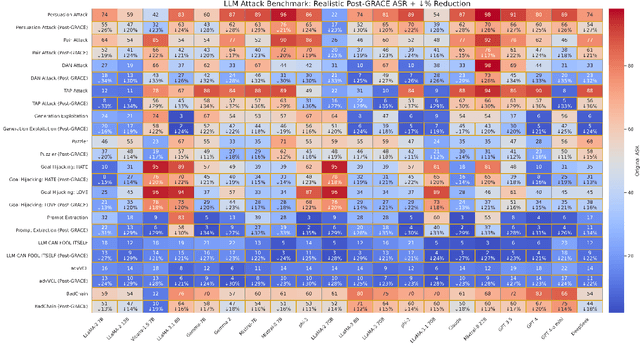
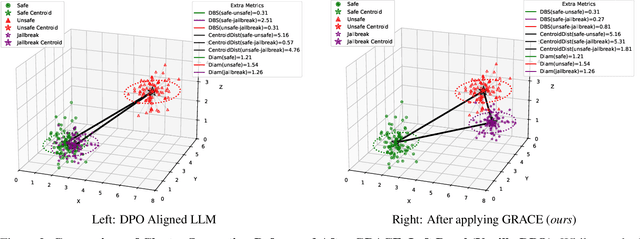

Abstract:Adversarial threats against LLMs are escalating faster than current defenses can adapt. We expose a critical geometric blind spot in alignment: adversarial prompts exploit latent camouflage, embedding perilously close to the safe representation manifold while encoding unsafe intent thereby evading surface level defenses like Direct Preference Optimization (DPO), which remain blind to the latent geometry. We introduce ALKALI, the first rigorously curated adversarial benchmark and the most comprehensive to date spanning 9,000 prompts across three macro categories, six subtypes, and fifteen attack families. Evaluation of 21 leading LLMs reveals alarmingly high Attack Success Rates (ASRs) across both open and closed source models, exposing an underlying vulnerability we term latent camouflage, a structural blind spot where adversarial completions mimic the latent geometry of safe ones. To mitigate this vulnerability, we introduce GRACE - Geometric Representation Aware Contrastive Enhancement, an alignment framework coupling preference learning with latent space regularization. GRACE enforces two constraints: latent separation between safe and adversarial completions, and adversarial cohesion among unsafe and jailbreak behaviors. These operate over layerwise pooled embeddings guided by a learned attention profile, reshaping internal geometry without modifying the base model, and achieve up to 39% ASR reduction. Moreover, we introduce AVQI, a geometry aware metric that quantifies latent alignment failure via cluster separation and compactness. AVQI reveals when unsafe completions mimic the geometry of safe ones, offering a principled lens into how models internally encode safety. We make the code publicly available at https://anonymous.4open.science/r/alkali-B416/README.md.
SetONet: A Deep Set-based Operator Network for Solving PDEs with permutation invariant variable input sampling
May 07, 2025Abstract:Neural operators, particularly the Deep Operator Network (DeepONet), have shown promise in learning mappings between function spaces for solving differential equations. However, standard DeepONet requires input functions to be sampled at fixed locations, limiting its applicability in scenarios with variable sensor configurations, missing data, or irregular grids. We introduce the Set Operator Network (SetONet), a novel architecture that integrates Deep Sets principles into the DeepONet framework to address this limitation. The core innovation lies in the SetONet branch network, which processes the input function as an unordered \emph{set} of location-value pairs. This design ensures permutation invariance with respect to the input points, making SetONet inherently robust to variations in the number and locations of sensors. SetONet learns richer, spatially-aware input representations by explicitly processing spatial coordinates and function values. We demonstrate SetONet's effectiveness on several benchmark problems, including derivative/anti-derivative operators, 1D Darcy flow, and 2D elasticity. Results show that SetONet successfully learns operators under variable input sampling conditions where standard DeepONet fails. Furthermore, SetONet is architecturally robust to sensor drop-off; unlike standard DeepONet, which requires methods like interpolation to function with missing data. Notably, SetONet can achieve comparable or improved accuracy over DeepONet on fixed grids, particularly for nonlinear problems, likely due to its enhanced input representation. SetONet provides a flexible and robust extension to the neural operator toolkit, significantly broadening the applicability of operator learning to problems with variable or incomplete input data.
MLPs and KANs for data-driven learning in physical problems: A performance comparison
Apr 15, 2025

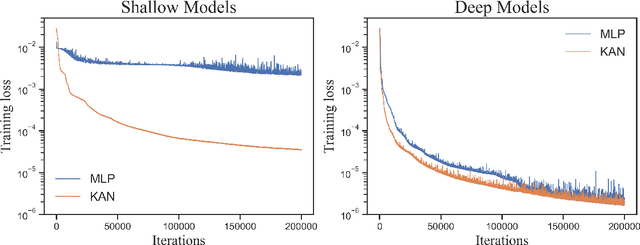

Abstract:There is increasing interest in solving partial differential equations (PDEs) by casting them as machine learning problems. Recently, there has been a spike in exploring Kolmogorov-Arnold Networks (KANs) as an alternative to traditional neural networks represented by Multi-Layer Perceptrons (MLPs). While showing promise, their performance advantages in physics-based problems remain largely unexplored. Several critical questions persist: Can KANs capture complex physical dynamics and under what conditions might they outperform traditional architectures? In this work, we present a comparative study of KANs and MLPs for learning physical systems governed by PDEs. We assess their performance when applied in deep operator networks (DeepONet) and graph network-based simulators (GNS), and test them on physical problems that vary significantly in scale and complexity. Drawing inspiration from the Kolmogorov Representation Theorem, we examine the behavior of KANs and MLPs across shallow and deep network architectures. Our results reveal that although KANs do not consistently outperform MLPs when configured as deep neural networks, they demonstrate superior expressiveness in shallow network settings, significantly outpacing MLPs in accuracy over our test cases. This suggests that KANs are a promising choice, offering a balance of efficiency and accuracy in applications involving physical systems.
Investigating the effect of CPT in lateral spreading prediction using Explainable AI
Mar 17, 2025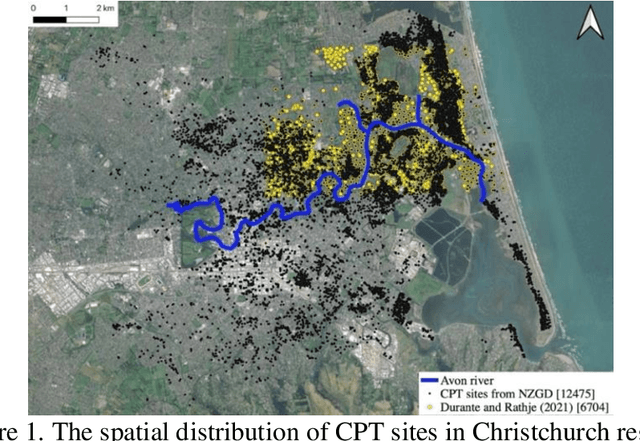
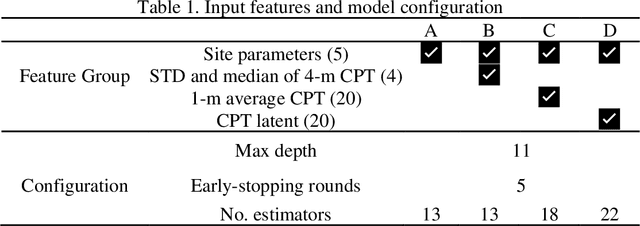
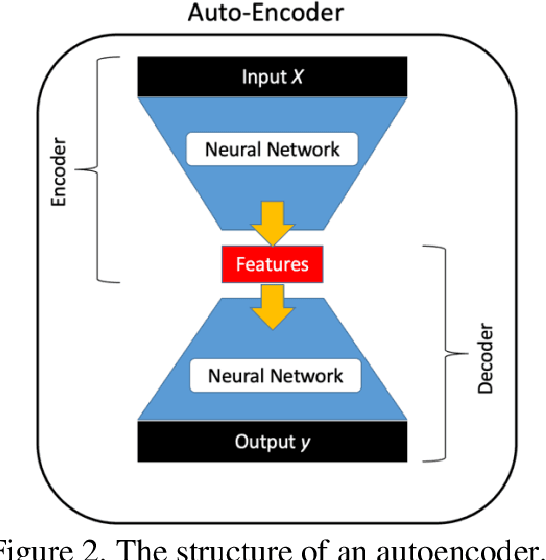
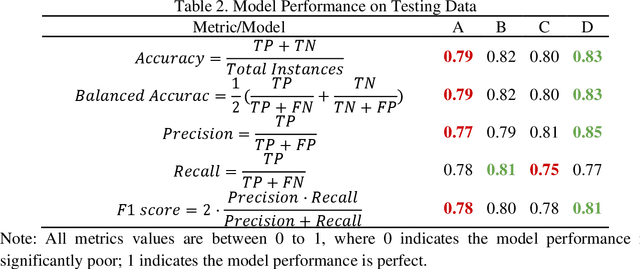
Abstract:This study proposes an autoencoder approach to extract latent features from cone penetration test profiles to evaluate the potential of incorporating CPT data in an AI model. We employ autoencoders to compress 200 CPT profiles of soil behavior type index (Ic) and normalized cone resistance (qc1Ncs) into ten latent features while preserving critical information. We then utilize the extracted latent features with site parameters to train XGBoost models for predicting lateral spreading occurrences in the 2011 Christchurch earthquake. Models using the latent CPT features outperformed models with conventional CPT metrics or no CPT data, achieving over 83% accuracy. Explainable AI revealed the most crucial latent feature corresponding to soil behavior between 1-3 meter depths, highlighting this depth range's criticality for liquefaction evaluation. The autoencoder approach provides an automated technique for condensing CPT profiles into informative latent features for machine-learning liquefaction models.
Machine Learning Aided Modeling of Granular Materials: A Review
Oct 18, 2024Abstract:Artificial intelligence (AI) has become a buzz word since Google's AlphaGo beat a world champion in 2017. In the past five years, machine learning as a subset of the broader category of AI has obtained considerable attention in the research community of granular materials. This work offers a detailed review of the recent advances in machine learning-aided studies of granular materials from the particle-particle interaction at the grain level to the macroscopic simulations of granular flow. This work will start with the application of machine learning in the microscopic particle-particle interaction and associated contact models. Then, different neural networks for learning the constitutive behaviour of granular materials will be reviewed and compared. Finally, the macroscopic simulations of practical engineering or boundary value problems based on the combination of neural networks and numerical methods are discussed. We hope readers will have a clear idea of the development of machine learning-aided modelling of granular materials via this comprehensive review work.
Explainable AI models for predicting liquefaction-induced lateral spreading
Apr 24, 2024Abstract:Earthquake-induced liquefaction can cause substantial lateral spreading, posing threats to infrastructure. Machine learning (ML) can improve lateral spreading prediction models by capturing complex soil characteristics and site conditions. However, the "black box" nature of ML models can hinder their adoption in critical decision-making. This study addresses this limitation by using SHapley Additive exPlanations (SHAP) to interpret an eXtreme Gradient Boosting (XGB) model for lateral spreading prediction, trained on data from the 2011 Christchurch Earthquake. SHAP analysis reveals the factors driving the model's predictions, enhancing transparency and allowing for comparison with established engineering knowledge. The results demonstrate that the XGB model successfully identifies the importance of soil characteristics derived from Cone Penetration Test (CPT) data in predicting lateral spreading, validating its alignment with domain understanding. This work highlights the value of explainable machine learning for reliable and informed decision-making in geotechnical engineering and hazard assessment.
Inverse analysis of granular flows using differentiable graph neural network simulator
Jan 17, 2024Abstract:Inverse problems in granular flows, such as landslides and debris flows, involve estimating material parameters or boundary conditions based on target runout profile. Traditional high-fidelity simulators for these inverse problems are computationally demanding, restricting the number of simulations possible. Additionally, their non-differentiable nature makes gradient-based optimization methods, known for their efficiency in high-dimensional problems, inapplicable. While machine learning-based surrogate models offer computational efficiency and differentiability, they often struggle to generalize beyond their training data due to their reliance on low-dimensional input-output mappings that fail to capture the complete physics of granular flows. We propose a novel differentiable graph neural network simulator (GNS) by combining reverse mode automatic differentiation of graph neural networks with gradient-based optimization for solving inverse problems. GNS learns the dynamics of granular flow by representing the system as a graph and predicts the evolution of the graph at the next time step, given the current state. The differentiable GNS shows optimization capabilities beyond the training data. We demonstrate the effectiveness of our method for inverse estimation across single and multi-parameter optimization problems, including evaluating material properties and boundary conditions for a target runout distance and designing baffle locations to limit a landslide runout. Our proposed differentiable GNS framework offers an orders of magnitude faster solution to these inverse problems than the conventional finite difference approach to gradient-based optimization.
Three-dimensional granular flow simulation using graph neural network-based learned simulator
Nov 13, 2023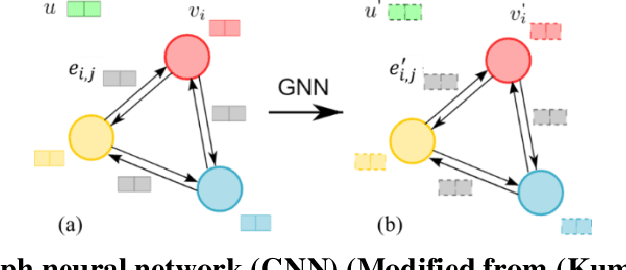
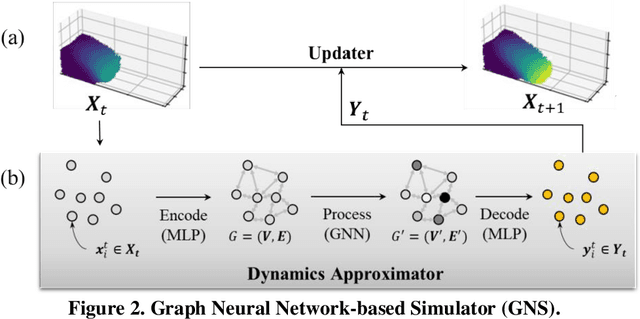

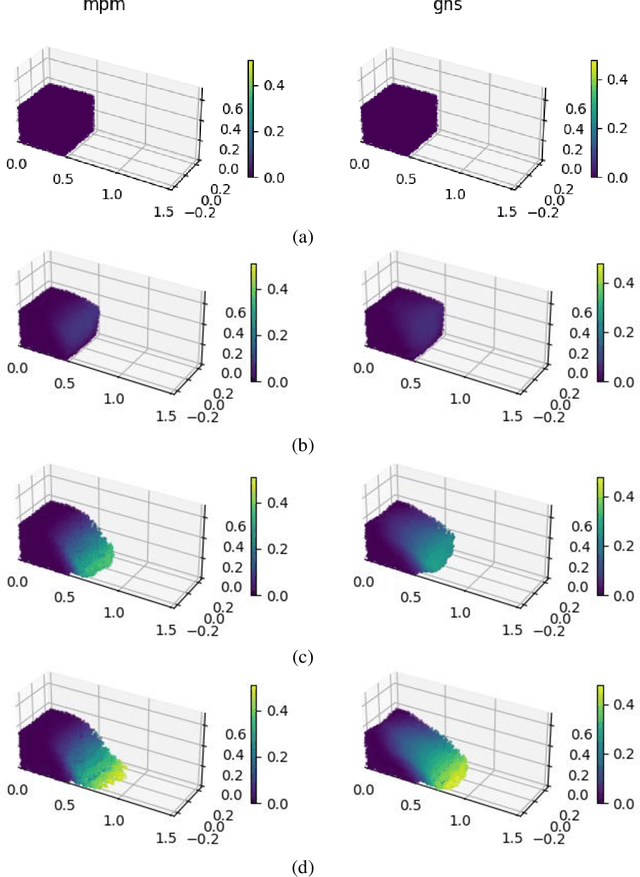
Abstract:Reliable evaluations of geotechnical hazards like landslides and debris flow require accurate simulation of granular flow dynamics. Traditional numerical methods can simulate the complex behaviors of such flows that involve solid-like to fluid-like transitions, but they are computationally intractable when simulating large-scale systems. Surrogate models based on statistical or machine learning methods are a viable alternative, but they are typically empirical and rely on a confined set of parameters in evaluating associated risks. Due to their permutation-dependent learning, conventional machine learning models require an unreasonably large amount of training data for building generalizable surrogate models. We employ a graph neural network (GNN), a novel deep learning technique, to develop a GNN-based simulator (GNS) for granular flows to address these issues. Graphs represent the state of granular flows and interactions, like the exchange of energy and momentum between grains, and GNN learns the local interaction law. GNS takes the current state of the granular flow and estimates the next state using Euler explicit integration. We train GNS on a limited set of granular flow trajectories and evaluate its performance in a three-dimensional granular column collapse domain. GNS successfully reproduces the overall behaviors of column collapses with various aspect ratios that were not encountered during training. The computation speed of GNS outperforms high-fidelity numerical simulators by 300 times.
Accelerating Particle and Fluid Simulations with Differentiable Graph Networks for Solving Forward and Inverse Problems
Sep 23, 2023Abstract:We leverage physics-embedded differentiable graph network simulators (GNS) to accelerate particulate and fluid simulations to solve forward and inverse problems. GNS represents the domain as a graph with particles as nodes and learned interactions as edges. Compared to modeling global dynamics, GNS enables learning local interaction laws through edge messages, improving its generalization to new environments. GNS achieves over 165x speedup for granular flow prediction compared to parallel CPU numerical simulations. We propose a novel hybrid GNS/Material Point Method (MPM) to accelerate forward simulations by minimizing error on a pure surrogate model by interleaving MPM in GNS rollouts to satisfy conservation laws and minimize errors achieving 24x speedup compared to pure numerical simulations. The differentiable GNS enables solving inverse problems through automatic differentiation, identifying material parameters that result in target runout distances. We demonstrate the ability of GNS to solve inverse problems by iteratively updating the friction angle (a material property) by computing the gradient of a loss function based on the final and target runouts, thereby identifying the friction angle that best matches the observed runout. The physics-embedded and differentiable simulators open an exciting new paradigm for AI-accelerated design, control, and optimization.
 Add to Chrome
Add to Chrome Add to Firefox
Add to Firefox Add to Edge
Add to Edge